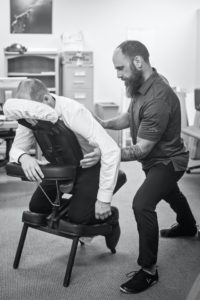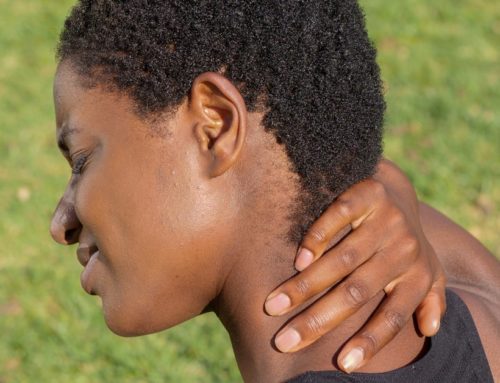With spring right around the corner, many of us are looking forward to taking up outdoor sports again. If you have an old injury that’s causing you pain or affecting your range of motion, you might feel like you can’t golf or cycle with the same dedication that you used to. There is a common misconception that old injuries can’t be treated. This is not true! There are several treatments available that can help improve your flexibility and range of motion as well as relieve your pain. Here’s are some to consider:
Acoustic Compression Therapy
Acoustic compression has been used for decades to help promote healing in new and old injuries. As the name suggests, acoustic compression uses sound waves. It is not the same as an ultrasound. The acoustic compression device generates a short sound wave that is over 1000x stronger than that used in ultrasound. This short, strong wave stimulates surrounding cells by causing tiny vibrations. The cellular stimulation breaks down scar tissue, increases blood flow, and desensitizes nerves that an injury has aggravated.
Often, old injuries cause pain and stiffness because of an excess of internal scar tissue. Breaking down this scar tissue with acoustic compression helps to mitigate these symptoms. It is not uncommon for nerves near an old injury to keep firing long after the initial damage has healed. Acoustic compression helps to stop these nerves from sending unneeded pain signals to the brain. These two benefits make acoustic compression the ideal therapy for many old injuries. It has been used successfully to treat various joint and soft tissue problems, including golfers elbow, tennis elbow, bursitis, muscle strains, torn ligaments, and sprains.
Acoustic compression is a non-invasive, comfortable experience. The area to be treated is uncovered, and a gel is applied to make the device’s movement easier. The device looks similar to an ultrasound device, and the treatment feels about the same. The technician can adjust the intensity of the sound waves to suit the patient’s needs. You may feel some mild discomfort when treating a sensitive area, but your technician will ask for your feedback and adjust accordingly to keep you comfortable.
Acoustic compression is FDA approved and has an excellent safety record. Mild side effects like redness and swelling at the treatment site have been reported. These are natural effects of your body’s healing processes being activated, and they usually go away after a day or two. Pregnant women and those with certain health conditions, like tumors or bleeding disorders, may not be able to receive treatment. Discuss your health conditions and medications with your treatment provider. They will be able to let you know if you are a good candidate.
Treatment sessions are relatively short, anywhere from 5 to 25 minutes, depending on the injury being treated. You may be asked to come in once or twice a week for a few weeks. Most patients experience lasting relief after completing a treatment regimen.

Laser Therapy
Laser therapy uses red and near-infrared spectrums of light that have been proven to stimulate circulation, decrease inflammation, and aid in healing. It has been in use for over thirty years and is FDA approved as a safe and effective treatment for musculoskeletal pain. The treatment is non-invasive and pain-free.
Laser therapy has been proven to decrease inflammation and pain and promote healing. The process is similar to photosynthesis in plants. Your body’s cells turn the light into energy. This stimulates the body to release endorphins (your body’s natural pain killers), speed up collagen synthesis, and encourage other healthy cell processes. The result is faster healing and less pain.
Like Acoustic compression therapy, Laser therapy is quick and convenient. Sessions are seldom longer than twenty minutes. Depending on the injury being treated, you may need a few sessions before you see lasting relief, but most people experience improvement after the first treatment.
Laser therapy is often used to treat recent injuries, but it can also help treat older injuries that are still causing pain or decreased range of motion. If swelling is present in the old injury, then laser therapy will likely be helpful. It can treat a variety of joint and soft tissue injuries, including knee pain and whiplash.
According to studies conducted about laser therapy’s effectiveness, 71% of patients with chronic back pain experienced a significant reduction of symptoms, and 45% said their pain was completely eliminated. Patients with knee injuries experienced improved knee flexion and pressure sensitivity after every laser therapy treatment.
Chiropractic Adjustment and Posture Correction
Even if your neck or back pain was caused by an accident that happened years ago, a chiropractic adjustment could help. Especially if you didn’t get adjusted right after the accident, you might have vertebrae that are out of alignment. Correcting the alignment of the spine reduces pain and stiffness and allows the nervous system to function optimally.
Certain injuries, like whiplash, can cause long-lasting effects on the curvature of your spine. People who have had a whiplash injury commonly lose some of the curve in their neck. Their head sits too far forward, and this incorrect posture continually strains the ligaments and muscles in the neck and shoulders. Corrective exercises to fix this type of posture problem can reduce pain and stiffness and keep the condition from worsening over time. With the correct regiment of exercises, the curve of the spine can be corrected, so you can function as you did before the injury.
Don’t let an old injury hold you back from pursuing the activities you love. Schedule an appointment today and find out how we can help you improve your range of motion and decrease your pain.







